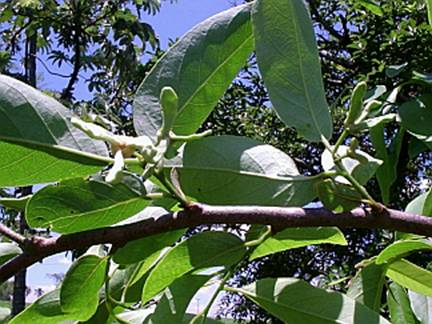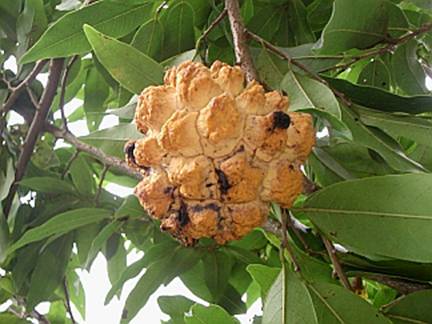ANNONA NEOSALICIFOLIA
FAMILIY OF ANNONACEAE
|
|
|
|
FLOWERS |
MATURE FRUITS |
NOMENCLATURE AND SIGNIFICATION: Araticum folha estreita originated from theTupi and means: “Fruit of the soft mass”. Also named as Araticum de bico, Araticum amarelo and Pinha de folha estreita.
NOTES: The old name Rollinia salicifolia is valid as synonym.
Origin: Occurs naturally in secondary formations of the Atlantic Rainforest. The plant occurs in various places in the southeastern and southern regions of Brazil. More informations in the Portuguese language at the link: http://floradobrasil.jbrj.gov.br/2012/index?mode=sv&group=Root_.Angiospermas_&family=Root_.Angiospermas_.Annonaceae_&genus=Annona&species=&author=&common=&occurs=1®ion=&state=&phyto=&endemic=&origin=&vegetation=&last_level=subspecies&listopt=1
Features: 6 to 8 metres tall tress with brown-whitish trunk of diameter of 30 to 40 cm. The new shoots are zigzag. The leaves are simple with short, yellowish stem or shank 0.8 t0 1.7 cm in length. The leaf is 5 to 10 cm long and 1.5 to 2.9 cm wide, has a lacet-shaped form with a wedge-shaped base and sharpened apex or tip. The flowers are cream and sit in the armpits and have helix with 3 petals, whose nectaries are at the base. The fruits consist of several united segments with or without seeds and yellow skin with black spots, they measure up to 7 cm long and 5 cm wide.
Culture tips: Subtropical plants which takes frosts to -3°C well, can be grown in whole Brazil, at every altitude, adapts well to sandy or loamy and red soils with quickly water drainage and acid or neutral pH and much solute organic matter.
Propagation: Seeds are gray-brown, triangular halfway and retain their ability to germinate up to 2 years with a clean, dry storage in a dark place. If sown shortly after harvest, they germinate within 40 to 75 days. The seedlings reach 40 cm at the age of 8 to 10 months, appreciate shady areas for development. The fruiting begins at 4 to 5 years, depending on soil and culture.
Planting: They can be planted in full sun or in mixed reforestation, they produce edible fruits for wildlife in general. Planting in the orchard, at intervals of 5 x 5 or 6 x 6 m, the holes should be 50 cm wide, deep and long, should be filled with 20% sand and about 8 kg of well mixed organic compost. If the soil is very acidic, add further 2 kg of lime and then leave for 3 months to act before planting. Water with 10 liters of water per week in the first 2 months.
Culture: Only forming cut of the crown and removing the shoots that grow from the base of the trunk or the intersecting branches within the crown. Fertilize with organic compost, it can be 5 to 6 kg of well-mixed poultry manure + 50 g of NPK 10-10-10 be, every year give until the second year twice, then fertilize once every spring. Remember, fertilize distribute a crown width of the trunk.
Use: Fruits in the months February and March. The fruits have a tasty pulp of white color, which looses easily from the seeds. The pulp can used for the production of juices, ice cream, cakes and sweets.
Back to the seedlist (English) or back to Annonaceae (Portuguese)

